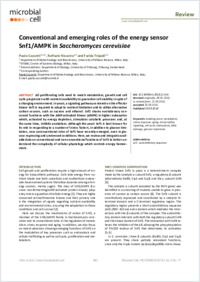Conventional and emerging roles of the energy sensor Snf1/AMPK in Saccharomyces cerevisiae
- Coccetti, Paola Department of Biotechnology and Biosciences, University of Milano-Bicocca, Milan, Italy - SYSBIO, Centre of Systems Biology, Milan, Italy
- Nicastro, Raffaele Department of Biotechnology and Biosciences, University of Milano-Bicocca, Milan, Italy - Department of Biology, University of Fribourg, Switzerland
- Tripodi, Farida Department of Biotechnology and Biosciences, University of Milano-Bicocca, Milan, Italy - SYSBIO, Centre of Systems Biology, Milan, Italy
-
29.09.2018
Published in:
- Microbial Cell. - 2018, vol. 5, no. 11, p. 482–494
English
All proliferating cells need to match metabolism, growth and cell cycle progression with nutrient availability to guarantee cell viability in spite of a changing environment. In yeast, a signaling pathway centered on the effector kinase Snf1 is required to adapt to nutrient limitation and to utilize alternative carbon sources, such as sucrose and ethanol. Snf1 shares evolutionary conserved functions with the AMP-activated Kinase (AMPK) in higher eukaryotes which, activated by energy depletion, stimulates catabolic processes and, at the same time, inhibits anabolism. Although the yeast Snf1 is best known for its role in responding to a number of stress factors, in addition to glucose limitation, new unconventional roles of Snf1 have recently emerged, even in glucose repressing and unstressed conditions. Here, we review and integrate available data on conventional and non-conventional functions of Snf1 to better understand the complexity of cellular physiology which controls energy homeostasis.
- Faculty
- Faculté des sciences et de médecine
- Department
- Département de Biologie
- Language
-
- English
- Classification
- Biological sciences
- License
-
License undefined
- Identifiers
-
- RERO DOC 323810
- DOI 10.15698/mic2018.11.655
- Persistent URL
- https://folia.unifr.ch/unifr/documents/307252
Statistics
Document views: 118
File downloads:
- pdf: 158
